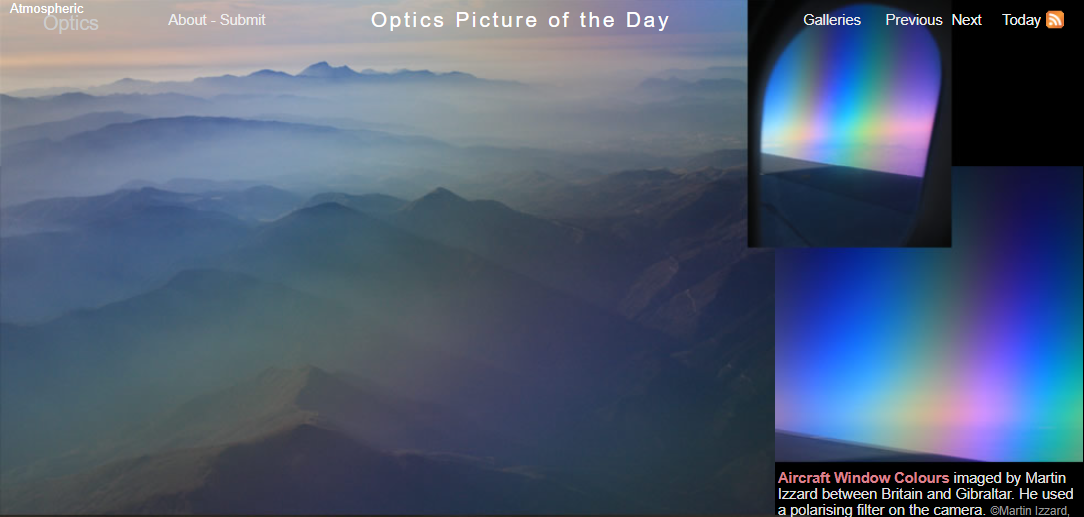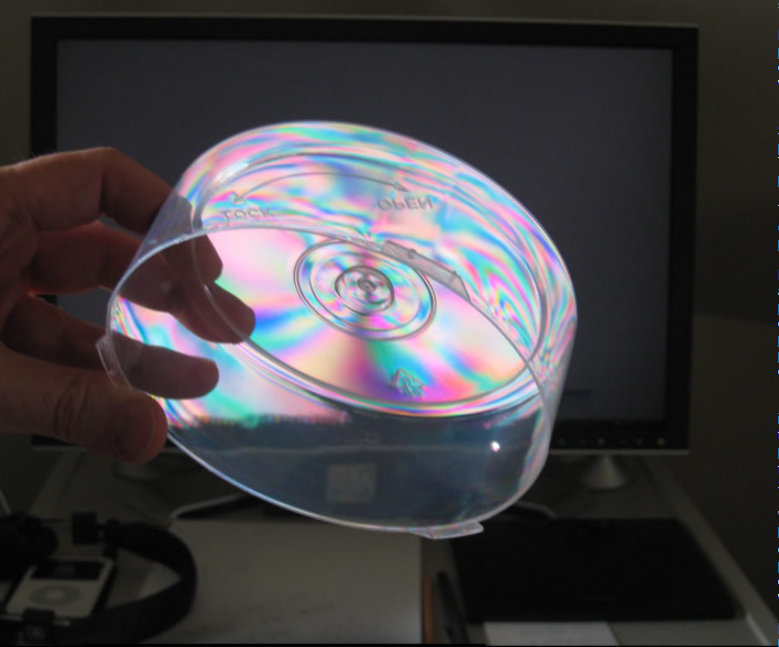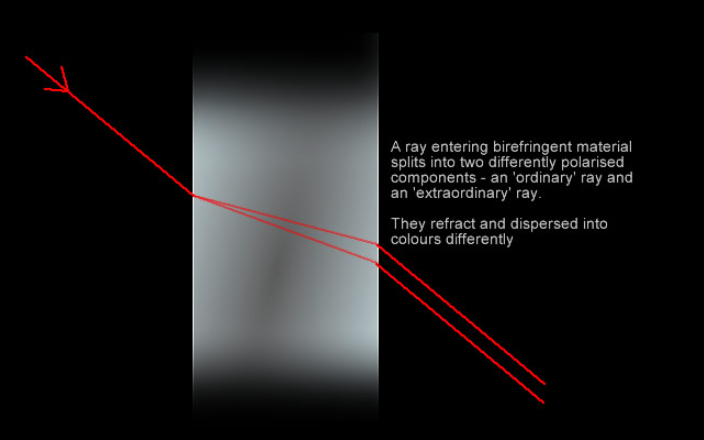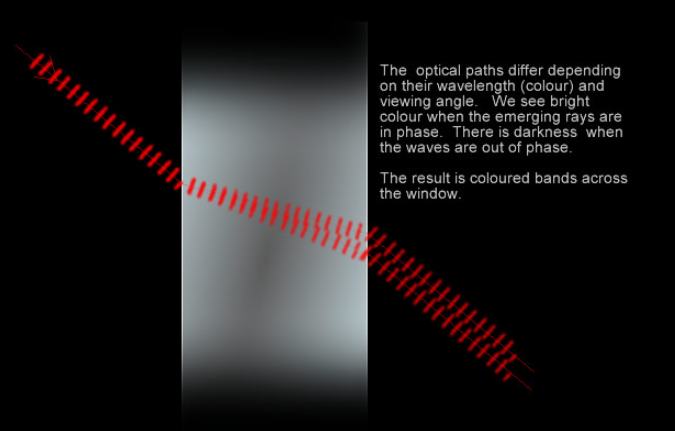Birefringence or why airplane windows colour views
Birefringence: Understanding Why Airplane Windows Color Views
When we look out of an airplane window, we may notice surprising color bands appearing in our view, especially when using a polarizing filter. These colorful phenomena can be explained by the interaction of several key factors: polarized light, the skylight, the plastic material of the window, and birefringence.
Polarized Light and Skylight
Light is a wave that oscillates in both electric and magnetic fields. Non-polarized light has its electric component oscillating in all possible directions perpendicular to the wave's travel. On the other hand, plane polarized light is more restricted, with its electric component varying in only one direction. When we look at the clear blue sky illuminating the landscape from the airplane window, the light is partially plane polarized. The extent of polarization depends on the angle from the sun and is most pronounced at a 90-degree angle.
The Birefringent Window
Airplane windows are typically made of thick plastic. During the production process or due to strains within the window, the plastic becomes slightly anisotropic, meaning its properties differ in different directions. Optically, this makes the window birefringent or double refracting.
Understanding Birefringence
In its simplest form, birefringence occurs when a material splits light entering it into two distinct rays that are polarized and refracted differently. Many crystalline materials exhibit birefringence, resulting in double images. For example, Iceland Spar is a well-known crystalline material that demonstrates birefringence. Surprisingly, even ice itself is slightly birefringent, leading to the formation of two components in everyday atmospheric phenomena like sundogs.
The Role of Birefringence in Color Bands
In addition to splitting light into two rays, birefringence also disperses their colors differently. The effects of this dispersion may not be readily apparent until we view the window through a polarizing filter. When observed through the filter, color bands become visible. These bands arise from constructive and destructive interference between the two rays passing through the birefringent window plastic. The slight difference in optical path lengths of the rays can cause their wave crests to either combine and produce a bright color or be out of phase and result in less or no light. The specific colors and patterns of the bands depend on the wavelength (color) and viewing angle, creating a visually captivating display across the window and the landscape beyond.
Exploring Birefringence: A Simple Experiment
If you're not flying anytime soon but still want to experience the fascinating effects of birefringence, you can simulate polarized skylight using a flat-screen computer monitor set to white. The screen emits polarized light, making it an excellent source for this experiment. By viewing or photographing the screen through a polarizing filter (e.g., sunglasses), you can observe the screen transitioning from light to almost dark as you rotate the filter. To further explore birefringence, place some plastic wrapping material or a transparent plastic lid between the screen and the filter. Most plastics will appear bright and exhibit color bands that change as you rotate the object. Interestingly, the colors also change when the plastic is deformed or stretched, as strain alters its degree of anisotropy and birefringence properties.
By understanding the concept of birefringence and its role in coloring our views through airplane windows, we gain a deeper appreciation for the complex interactions of light and materials in our everyday surroundings. Whether observing the sky from above or conducting simple experiments with polarized light, exploring these optical phenomena can bring a sense of wonder to our understanding of the world around us.


Aircraft Window Colours imaged by Martin Izzard between Britain and Gibraltar. He used a polarising filter on the camera. ©Martin Izzard, shown with permission.
Birefringence in a Plastic Lid visualised by polarised light from a computer monitor. The camera polariser was turned until the bright white monitor screen looked dark. ©Les Cowley.
Surprising colour bands often appear in pictures taken through airplane windows. They are especially intense when using a polarising filter.
There are several keys to what is going on: (1) polarised light, (2) the skylight, (3) the plastic of the window and (4) birefringence.
Polarised light: Light is a transverse electric and magnetic oscillation - a wave. Non polarised light has its oscillating electric component in all the possible directions perpendicular to the wave travel. Plane polarised light is more restricted - its electric component varies in only one direction.
Skylight: The light of the clear blue sky illuminating the landscape and flooding through the airplane window is partially plane polarised. The extent depends on the angle from the sun and is greatest at 90�. See Eva Seidenfaden's series of images.
Window: Airplane windows have at least one layer of thick plastic. The production process, or strains within the window, renders the plastic slightly anisotropic, i.e. its properties differ in different directions. Optically, the window is birefringent or double refracting.
Birefringence: In the simplest type of birefringence the material splits light entering it into two distinct rays which are polarised and refracted differently.
Many crystalline materials are birefringent and their split rays give double images. Iceland Spar is a familiar example obtainable from mineral stores. Less well known is that ice is also slightly birefringent and as a result the everyday sundog has two components that can be separated if some care is taken with polarising filters - see Richard Fleet's excellent sets of images.
The two rays also have their colours dispersed differently. The effects of this are not very apparent until we view the window through a polarising filter. Then we see colour bands. They arise from constructive and destructive interference between the two rays. The two rays passing through the birefringent window plastic have slightly different optical path lengths. On leaving, their wave crests can be in phase and combine to give a bright colour. They can be out of phase giving less or no light. The phase condition depends on the wavelength (colour) and the viewing angle. The result is a series of coloured bands crossing the window and the landscape beyond.
Not flying soon? Simulate polarised skylight with a flat screen computer monitor set to white - an excellent source of polarised light. View or photograph the screen through a polarising filter, some sunglasses will do. If the filter is rotated the screen will go from light to almost dark. The dark condition is when the filter is only accepting light polarised at right angles to the direction of polarization emitted by the screen.
Keep the filter in the dark screen position. Now place some plastic wrapping material or a transparent plastic lid between the screen and filter. Most plastics will appear bright and show colour bands that change as the object is rotated. The colours also change when the plastic is deformed or stretched because strain alters the degree of anisotropy and the birefringence properties.

A ray entering birefringent material splits into two differently polarised components - an 'ordinary' ray and an 'extraordinary' ray.
They refract and dispersed into colours differently

The optical paths differ depending on their wavelength (colour) and viewing angle. We see bright colour when the emerging rays are in phase. There is darkness when the waves are out of phase.
The result is coloured bands across the window.
Note: this article has been automatically converted from the old site and may not appear as intended. You can find the original article here.
Reference Atmospheric Optics
If you use any of the definitions, information, or data presented on Atmospheric Optics, please copy the link or reference below to properly credit us as the reference source. Thank you!
-
<a href="https://atoptics.co.uk/blog/birefringence-or-why-airplane-windows-colour-views/">Birefringence or why airplane windows colour views</a>
-
"Birefringence or why airplane windows colour views". Atmospheric Optics. Accessed on April 24, 2024. https://atoptics.co.uk/blog/birefringence-or-why-airplane-windows-colour-views/.
-
"Birefringence or why airplane windows colour views". Atmospheric Optics, https://atoptics.co.uk/blog/birefringence-or-why-airplane-windows-colour-views/. Accessed 24 April, 2024
-
Birefringence or why airplane windows colour views. Atmospheric Optics. Retrieved from https://atoptics.co.uk/blog/birefringence-or-why-airplane-windows-colour-views/.